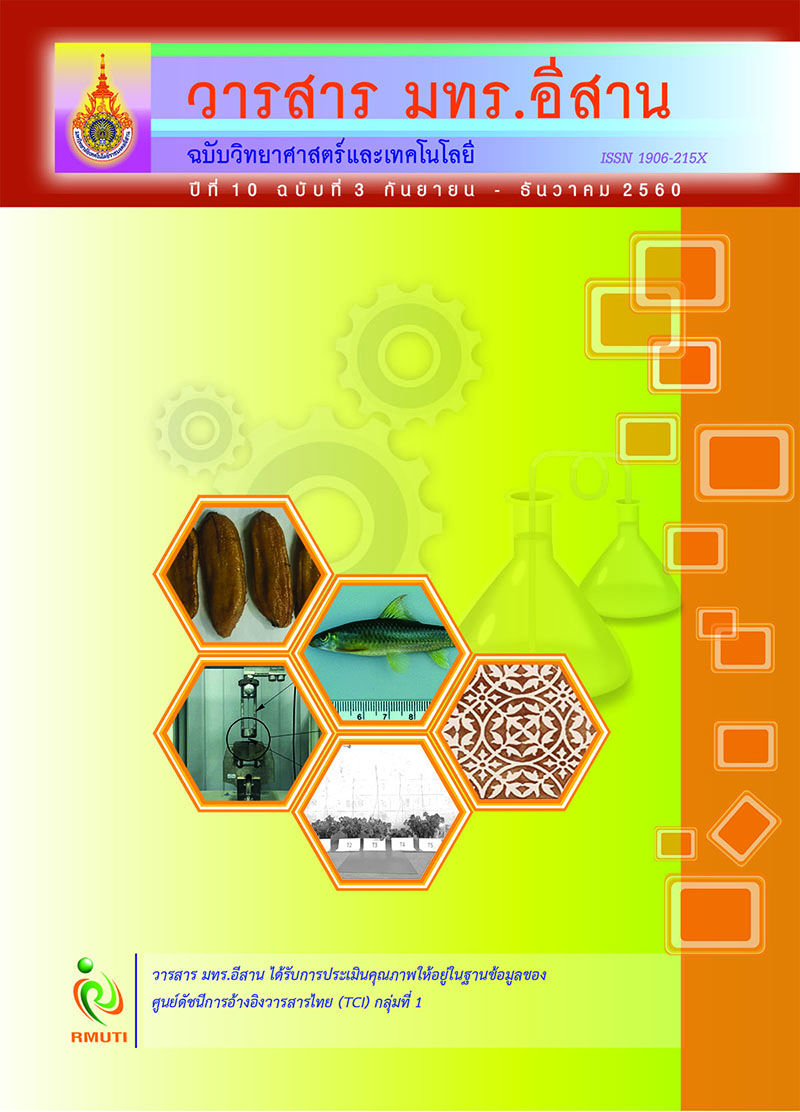การผลิตแก๊สชีวภาพจากเศษอาหารเข้มข้นในถังปฏิกรณ์แบบกวนต่อเนื่อง Biogas Production from Concentrated Food Waste by Using Continuous Stirred Tank Reactor (CSTR)
Main Article Content
Abstract
บทคัดย่อ
ในงานวิจัยนี้ทำการศึกษาการผลิตแก๊สชีวภาพจากเศษอาหารเข้มข้นด้วยกระบวนการหมักแบบไร้อากาศโดยใช้ถังปฏิกรณ์แบบกวนต่อเนื่อง ณ อุณหภูมิเมโซฟิลิก (37 องศาเซลเซียส) และไม่มีการควบคุมค้าความเป็นกรดด่างที่อัตราภาระบรรทุกสารอินทรีย์แตกต่างกัน จากการศึกษาพบว่า แก๊สชีวภาพที่ผลิตได้ประกอบด้วย แก๊สมีเทน และแก๊สคาร์บอนไดออกไซด์เป็นหลักที่อัตราภาระบรรทุกสารอินทรีย์ที่ 8.71 กิโลกรัมต่อลูกบาศก์เมตรต่อวัน (ระยะเวลากักเก็บ = 3.15 วัน) เป็นอัตราภาระบรรทุกสารอินทรีย์ที่เหมาะสมต่อการผลิตแก๊สชีวภาพ ซึ่งแสดงให้เห็นในรูปของประสิทธิภาพในการผลิตแก๊สมีเทนที่สูงที่สุด คือ ผลได้ของแก๊สมีเทนที่สูงที่สุดและอัตราการผลิตแก๊สมีเทนจำเพาะเจาะจงที่สูงที่สุดเท่ากับ 14.52 มิลลิลิตรมีเทนต่อกรัมซีโอดีที่ถูกใช้ไป หรือ 1.13 มิลลิลิตรมีเทนต่อกรัมซีโอดีเริ่มต้น และ 0.48 มิลลิลิตรมีเทนต่อกรัม จุลินทรีย์ที่อยู่ในระบบต่อวัน หรือ 8.50 มิลลิลิตรมีเทนต่อลิตรต่อวัน ตามลำดับ ซึ่งสัมพันธ์กับประสิทธิภาพการย่อยสลายสารอินทรีย์ที่มากที่สุด (COD Removal) คิดเป็นร้อยละ 38 และสารประเภทไขมันสามารถย่อยสลายได้ประมาณร้อยละ 79.25 ภายใต้สภาวะที่ศึกษานี้
Abstract
The objective of this study was to investigate biogas production from concentrated food waste by using anaerobic continuous stirred tank reactor (CSTR) under mesophilic operation without pH control at different chemical oxygen demand (COD) loading rates. The main components of biogas were methane and carbon dioxide. Under optimum COD loading rate of 8.71 kg/m3d (Hydraulic retention time, HRT = 3.15 day), the system provided the highest biogas production performance in terms of the highest methane yield (14.52 ml CH4/g COD removed or 1.13 ml CH4/g COD added) and the highest specific methane production rate (SMPR) (0.48 ml CH4/g MLVSS d or 8.50 ml CH4/L d) which was consistent with the maximum COD removal of 38, and 79.25 % of lipid could be break down under the studied condition.
Article Details
References
[2] The Institute for the Promotion of Teaching Science and Technology (IPST). (2011). Science Math and Technology. Access (30 August 2016). Available (https://www.scimath.org/)
[3] Osamu M., Richard D., Freda R. H., Dennis L. H., and Tatsuya N. (2000). Enhancement of Hydrogen Production from Glucose by Nitrogen Gas Sparging. Bioresource Technology. Vol. 73. No. 1. pp. 59-65
[4] llgi Karapinar K., and Fikret K. (2006). Bio-Hydrogen Production from Waste Materials. Enzyme and Microbial Technology. Vol. 38. Issue 5. pp. 569-582
[5] Venkata Mohan S., Lalit Babu V., and Sarma P.N. (2007). Anaerobic Biohydrogen Production from Dairy Wastewater Treatment in Sequencing Batch Reactor (AnSBR): Effects of Organic Loading Rate. Enzyme and Microbial Technology. Vol. 41. No. 4. pp. 506-515
[6] Sun-kee H., and Hang-sik S. (2004). Biohydrogen Production by Anaerobic Fermentation of Food Waste. International Journal of Hydrogen Energy. Vol. 29. pp. 569-577
[7] Guangqing L., Ruihong Z., Hamed M.E., and Renjie D. (2009). Effect of Feed to Inoculum Ratios on Biogas Yields of Food and Green Wastes. Bioresource Technology. Vol. 100. pp. 5103-5108
[8] Suchada T., Sarunyou W., Verawat C., Malinee L., Annop N., Somkiet T., and Pawinee C. (2013). Enhancement of Biogas Production from Swine Manure by a Lignocellulolytic Microbial Consortium. Bioresource Technology. Vol. 144. pp. 579-586. DOI: 10.1016/j.biortech.2013.07.013.
[9] Castrillon L., Fernandez-Nava Y., Ormaechea P., and Maranon E. (2013). Methane Production from Cattle Manure Supplemented with Crude Glycerin from the Biodiesel Industry in CSTR and IBR. Bioresource Technology. Vol. 127. pp. 312-317
[10] Giorgos M. (2015). Improved Anaerobic Digestion Performance and Biogas Production from Poultry Litter After Lowering its Nitrogen Content. Bioresource Technology. Vol. 196. pp. 726-730
[11] Reukrit K. (2005). Planning Strategic and Energy Policy and Planning Office, Energy Policy and Planning Office. Access (30 August 2016). Available (https://gphone.prd.go.th/dp.php?MID=22&DID=176)
[12] Tasneem A., Tauseef S.M., and Abbasi S.A. (2012). Anaerobic Digestion for Global Warming Control and Energy Generation-An Overview. Renewable and Sustainable Energy. Vol. 16. Issue 5. pp. 3228-3242
[13] Khanitta M. (2010). Hydrogen Production. Journal of Academic Services Center Faculty of Technology Khonkaen University. Vol. 18. No. 3-4. pp.15-20 (in Thai)
[14] Sirirat S., and Pramoj C. (2005). Biological Wastewater Treatment. Occupational Health and Environment Department of Health Science Sukhothai Thammathirat Open University. Access (30 August 2016). Available (https://www.stou.ac.th/Schools/Shs/booklet/6_2548/OccHealth.htm)
[15] Thammanoon S., Suchawadee C., Pramoch R., and Sumaeth C. (2010). Hydrogen Production from Cassava Wastewater Using an Aerobic Sequencing Batch Reactor: Effects of Operational Parameters, COD: N Ratio, and Organic Acid Composition. International Journal of Hydrogen Energy. Vol. 35. pp. 4092-4102
[16] Patcharee I., Pramoch R., Weerachart N., Bandhit T., Jittipan C., and Sumaeth C. (2012). Hydrogen Production from Alcohol Wastewater by an Anaerobic Sequencing Batch Reactor Under Thermophilic Operation: Nitrogen and Phosphorous Uptakes and Transformation. International Journal of Hydrogen Energy. Vol. 37. pp. 11104-11112
[17] Pawinee S., Pramoch R., Malinee L., and Sumaeth C. (2010). Hydrogen Production from Alcohol Distillery Wastewater Containing High Potassium and Sulfate Using an Anaerobic Sequencing Batch Reactor. International Journal of Hydrogen Energy. Vol. 36. pp. 12810-12821
[18] Sittijunda S. (2014). Biogas Production from Co-Digestion of Hydrolysate of Microwave Assisted Sulfuric Acid Pretreated Napier Grass and Slaughterhouse Wastewater. KKU Research Journal. Vol. 20. pp. 323-336 (in Thai)
[19] Eaton A.D., Clesceri L.S., Rice E.W., and Greenberg A.E. (2005). American Public Health Association (APHA), American Water Works Association (AWWA) & Water Environment Federation (WEF): Standard Methods for the Examination of Water and Wastewater. Washington DC.
[20] Shaobo L., and Armando G.M. (2015). Anaerobic Digestion of Pre-Fermented Potato Peel Wastes for Methane Production. Waste Management. Vol. 46. pp. 197-200
[21] Mani S., Sundaram J., and Das K.C. (2016). Process Simulation and Modelling: Anaerobic Digestion of Complex Organic Matter. Biomass and Bioenergy. Vol. 93. pp. 158-167
[22] Jingqing Y., Dong L., Yongming S., Guohui W., Zhenhong Y., Feng Z., and Yai W. (2013). Improved Biogas Production from Rice Straw by Co-Digestion with Kitchen Waste and Pig Manure. Waste Management. Vol. 33. pp. 2653-2658
[23] Kvesitadze G., Sadunishvili T., Dudauri T., Zakariashvili N., Partskhaladze G., Ugrekhelidze V., Tsiklauri G., Metreveli B., and Jobava M. (2012). Two-Stage Anaerobic Process for Bio-Hydrogen and Bio-Methane Combined Production from Biodegradable Solid Wastes. Energy. Vol. 37. pp. 94-102
[24] Astals S., Ariso M., Gali A., and Mata-Alvarez J. (2011). Co-Digestion of Pig Manure and Glycerine: Experimental and Modelling Study. Journal of Environmental Management. Vol. 92. pp. 1091-1096
[25] Chavalit R. and Panlekha M. (2016). Comparative Assessment of Prototype Digestion Configuration for Biogas Recovery from Anaerobic Co-Digestion of Food Waste and Rain Tree Leaf Feedstock. International Biodeterioration and Biodegradation. Vol. 113. pp. 367-374


